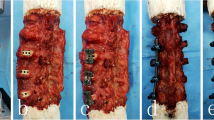Abstract.
Many studies have concluded that stand alone cages provide limited stabilization to the spine, and this primary stabilization decreases postoperatively due to various factors. A supplemental fixation may, therefore, be needed to improve the stability. Extensive biomechanical analysis was performed in the present study to further evaluate the stabilization achieved by a laterally inserted cage and the role of an anterior lateral supplemental fixation. Eight human cadaver functional spinal units were subjected sequentially to four different test conditions: (1) intact, (2) instrumented laterally with a long cylindrical threaded cage, (3) the same cage supplemented with a lateral fixation plate, the plate being firmly connected to the cage, and (4) removal of the connection between the plate and the cage. Pure moments were applied to each specimen in a quasi static manner, ranging from –7 Nm to 7 Nm in flexion/extension, lateral bending and axial rotation. Three-dimensional segmental motions were simultaneously recorded under each loading condition. Statistical analysis was carried out on the motion parameters, including the range of motion (ROM) and the neutral zone (NZ). Inter-group comparisons were made using the Friedman test and the Wilcoxon test. The results showed that the stand alone lateral cage provided stabilization by increasing segmental stiffness above that of the intact spine. The stiffness increase ratios were: 1.6 in flexion/extension (P=0.07), 1.3 in lateral bending (P=0.4) and 1.0 in axial rotation (P=0.67). A supplemental plate provided significant reinforcement of the stabilization. The stiffness increase ratios relative to the intact spine were: 3.1 in flexion/extension (P=0.012), 5.0 in lateral bending (P=0.012) and 2.3 in axial rotation (P=0.012). After removal of the connection between the cage and the plate, the stiffness ratios were: 2.7 in flexion/extension (P=0.027), 4.6 in lateral bending (P=0.027) and 2.1 in axial rotation (P=0.027). Globally, the cage alone increased the segmental stiffness above that of the intact spine by a factor of 1.1 (P=0.39), with the supplemental plate, segmental stiffness increased by a factor of 3.1 (P<0.01), and the unconnected cage/plate increased stiffness by a factor of 3.0 (P=0.02). Supplementation of the lateral cage with an anterolateral plate was thus shown to provide significant additional stabilization in all directions, which may potentially compensate for the postoperative decrease in segmental stability.
Similar content being viewed by others
Author information
Authors and Affiliations
Additional information
Electronic Publication
Rights and permissions
About this article
Cite this article
Le Huec, J., Liu, M., Skalli, W. et al. Lumbar lateral interbody cage with plate augmentation: in vitro biomechanical analysis. Eur Spine J 11, 130–136 (2002). https://doi.org/10.1007/s005860100316
Received:
Revised:
Accepted:
Published:
Issue Date:
DOI: https://doi.org/10.1007/s005860100316




